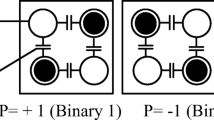Abstract
In this paper, a unique gate is presented for the design of reversible flip-flops in quantum-dot cellular automata technology. The proposed gate is implemented with multiplexer, three-input Majority gate and XOR gate. The proposed gate has four input lines and four output lines. This gate is designed without garbage outputs. In other words, each output determines the function of each of flip-flops. The proposed structure is evaluated by the QCADesigner. The result of the simulation represents that the operations of the proposed structure is as expected and all functions are correct. Also, the evaluation results show that the proposed structure has significant improvement in area, cell numbers and delay compared to the previous structures. QCAPro tool is used to estimate energy consumption of the proposed structure.






















Similar content being viewed by others
References
Karkaj, E.T., Heikalabad, S.R.: A testable parity conservative gate in quantum-dot cellular automata. Superlattice. Microst. https://doi.org/10.1016/j.spmi.2016.08.054 (2016)
Compano, R., Molenkamp, L., Paul, D.J.: Technology Roadmap for Nanoelectronics, European Commission IST Prpgramme, Future and Emerging Tecnologies (2000)
Lent, C.S., Tougaw, P.D., Porod, W., Bernstein, G.H.: Quantum cellular automata. Nanotechnology 4(1), 49–57 (1993)
Karkaj, E.T., Heikalabad, S.R.: Binary to gray and gray to binary converter in quantum-dot cellular automata. Optik - Int. J. Light Electron. Opt. 130. https://doi.org/10.1016/j.ijleo.2016.11.087 (2017)
IEEE: International symposium on circuit and systems, 2004. QCA: a promising research area for CAS society
Hashemi, S., Navi, K.: New robust QCA D flip flop and memory structures. Microelectron. J. 43(12), 929–940 (2012)
Tougaw, P.D., Lent, C.S.: Logical devices implemented using quantum cellular automara. Appl. Phys. 75, 1818–1824 (1994)
Shamsabadi, A.S., Ghahfarokhi, B.S., Zamanifar, K., Movahedinia, N.: Applying inherent capabilities of quantum-dot cellular automata to design: D flip-flop case study. J. Syst. Archit. 55(3), 180–187 (2008)
Heikalabad, S.R., Navin, A.H., Hosseinzadeh, M.: Content addressable memory cell in quantum-dot cellular automata. Microelectron. Eng. 163, 140–150 (2016)
Rad, S.K., Heikalabad, S.R.: Reversible flip-flops in quantum-dot cellular automata. Int. J. Theor. Phys. 56, 2990–3004 (2017)
Jayashree, R., Kiran Kumar, M., Selvakuma, J.: Design and analysis of flip flops using reversible logic. IJAIST 23(23), 210–217 (2014)
Asfestani, M.N., Heikalabad, S.R.: A unique structure for the multiplexer in quantum-dot cellular automata to create a revolution in design of nanostructures. Phys. B Condens. Matter 512, 91–99 (2017). https://doi.org/10.1016/j.physb.2017.02.028
Debarka, M., Dutta, P.: A Study on energy optimized 4 to 2 electron two dimensional quantum dot cellular automata logical reversible flip-flops. Microelectron. J. 46(6), 519–530 (2015)
Asfestani, M.N., Heikalabad, S.R.: A novel multiplexer-based structure for random access memory cell in quantum-dot cellular automata. Phys. B Condens. Matter 521, 162–167 (2017). https://doi.org/10.1016/j.physb.2017.06.059
Barughi, Y.Z., Heikalabad, S.R.: A Three-Layer Full Adder/Subtractor Structure in Quantum-Dot Cellular Automata. Int. J. Theor. Phys. https://doi.org/10.1007/s10773-017-3453-0 (2017)
Walus, K., Dysart, T.J., Jullien, G.A., Budiman, R.A.: QCAD Esigner: a rapid design and simulation tool for quantum-dot cellular automata. IEEE Trans. Nanotechnol 3(1), 26–31 (2004)
Srivastava, S., Asthana, A., Bhanja, S., Sarkar, S.: QCAPRo-an error power estimation tool for QCA circuit design. In: Proceedings of the IEEE International Symposium Circuits System, pp. 2377–2380 (2011)
Ali, B., Hossin, M., Ullah, E.: Design of reversible sequential circuit using reversible logic synthesis. International Journal of VLSI design and Communication Systems (VLSICS) 4, 2 (2011)
Chabi, A.M., et al.: Towards ultra-efficient QCA reversible circuits. Microprocess. Microsyst. 49, 127–138 (2017)
Tangmettajittakul, O., Thainoi, S., Changmoang, P., Kanjanachuchai, S., Rattanathammaphan, S., Panyakeow, S.: Extended optical properties beyond band-edge of GaAs by InAs quantum dots and quantum dot molecules. Microelectron. Eng. 87(5–8), 1304–1307 (2010). https://doi.org/10.1016/j.mee.2009.12.063
Yu, W., Zhang, B., Liu, C., Zhao, Y., Wu, W.R., Xue, Z.Y., Chen, M., Buca, D., Hartmann, J. -M., Wang, X., Zhao, Q.T., Mantl, S.: Impact of Si cap, strain and temperature on the hole mobility of (s)si/ssige/(s)SOI quantum-well p-MOSFETs. Microelectron. Eng. 113, 5–9 (2014). https://doi.org/10.1016/j.mee.2013.06.015
Debnath, B., Das, J.C.: Design of image steganographic architecture using quantum-dot cellular automata for secure nanocommunication networks. Nano Commun. Networks 15, 41–58 (2018)
Bose, R., Johnson, H.T.: Coulomb interaction energy in optical and quantum computing applications of self-assembled quantum dots. Microelectron. Eng. 75(1), 43–53 (2004). https://doi.org/10.1016/j.mee.2003.11.008
Smith, C.: Realization of quantum-dot cellular automata using semiconductor quantum dots. Superlattices Microstruct. 34, 195–203 (2003)
Das, J.C., De, D.: Circuit switching with quantum-dot cellular automata. Nano Commun. Networks 14, 16–28 (2017)
Gadim, M.R., Navimipour, N.J.: A new three-level fault tolerance arithmetic and logic unit based on quantum dot cellular automata. Microsystem Technologies (2017)
Khan, A.: Static hazard elimination for a logical circuit using quantum dot cellular automata. Microsyst. Technol. 23(9), 4169–4177 (2017)
Kassa, S., Nagaria, R.K.: Energy efficient neoteric design of a 3-input majority gate with its implementation and physical proof in quantum dot cellular automata. Nano Commun. Networks 15, 28–40 (2018)
Ghosh, M.: Design of an arithmetic circuit using non-reversible adders in 2 dot 1 electron QCA. Microsystem Technologies (2017)
Datta, K.: Comprehensive study on the performance comparison of logically reversible and irreversible parity generator and checker designs using two-dimensional two-dot one-electron QCA. Microsystem Technologies (2017)
Seyedi, S., Navimipour, N.J.: Design and evaluation of a new structure for fault-tolerance full-adder based on quantum-dot cellular automata. Nano Commun. Networks 16, 1–9 (2018)
Sadoghifar, A., Heikalabad, S.R.: A content-addressable memory structure using quantum cells in nanotechnology with energy dissipation analysis. Phys. B Condens. Matter 537, 202–206 (2018). https://doi.org/10.1016/j.physb.2018.02.024
Hosseinzadeh, H., Heikalabad, S.R.: A novel fault tolerant majority gate in quantum-dot cellular automata to create a revolution in design of fault tolerant nanostructures, with physical verification. Microelectron. Eng. 192, 52–60 (2018). https://doi.org/10.1016/j.mee.2018.01.019
Heikalabad, S.R., Asfestani, M.N., Hosseinzadeh, M.: A full adder structure without crosswiring in quantum-dot cellular automata with energy dissipation analysis. J. Supercomput. https://doi.org/10.1007/s11227-017-2206-4 (2017)
Heikalabad, S.R., Gadim, M.R.: Design of improved arithmetic logic unit in Quantum-Dot cellular automata. International Journal of Theoretical Physics (2018)
Author information
Authors and Affiliations
Corresponding author
Rights and permissions
About this article
Cite this article
Kamrani, S., Heikalabad, S.R. A Unique Reversible Gate in Quantum-dot Cellular Automata for Implementation of Four Flip-flops Without Garbage Outputs. Int J Theor Phys 57, 3340–3358 (2018). https://doi.org/10.1007/s10773-018-3847-7
Received:
Accepted:
Published:
Issue Date:
DOI: https://doi.org/10.1007/s10773-018-3847-7




